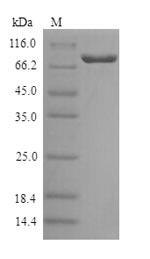The production of this Recombinant Human GALC protein started with the GALC gene synthesis. And then using recombinant DNA technology, the GALC gene was inserted into an expression vector so that we could get the recombinant express plasmid of GALC. Transform the plasmid into the cells of Yeast, culture the cells and we could get the desired Recombinant Human GALC protein. But the work was not completed, protein purification and a strict QC system were performed in the last step. The purity is 90%+ determined by SDS-PAGE.
GALC is a gene providing an instruction of making a protein named galactocerebrosidase (GALC) in human. The protein encoded by this gene has several alternative names, including galactocerebroside beta-galactosidase, galactosylceramidase1 and galactosylceramide beta-galactosidase. GALC protein is an enzyme that removes galactose from ceramide derivatives (galactosylceramides). This protein is involved in three biological processes, including galactosylceramide catabolic process, glycosphingolipid metabolic process and myelination.




